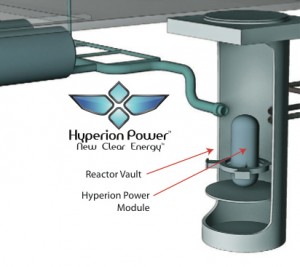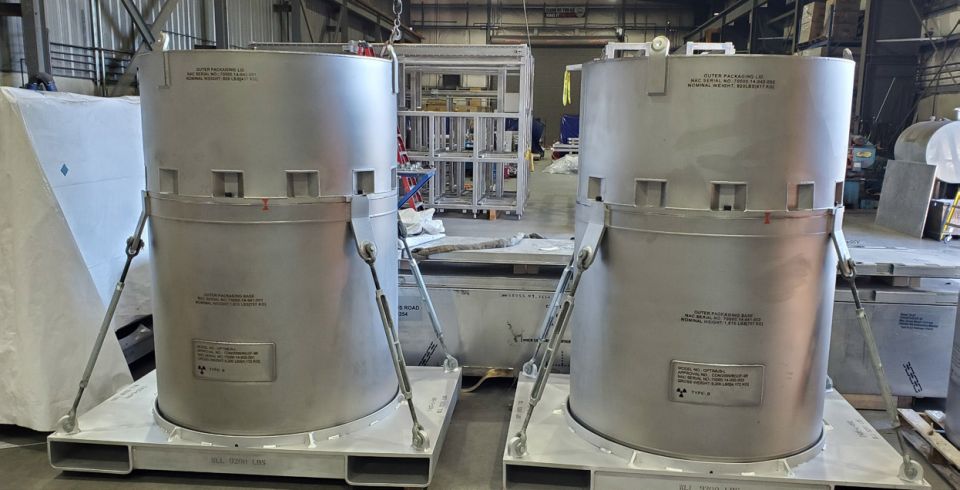Advantages of SMRs

NuScale's containment vessel showing the reactor pressure vessel (Graphic: NuScale Power)
Whereas SMRs start off with an apparent disadvantage due to lack of economy of scale, it is hoped that with volume production, assembly-line-produced reactors could wind up being cheaper than site-constructed large reactors. Performing the fabrication of the reactor and all other nuclear safety related components at a single, dedicated factory site may also result in a higher level of quality control and minimize construction defects.
In addition to the raw cost, SMRs may have less difficulty in obtaining financing than large reactors, and may enjoy lower financing costs (interest rates). This is due to several factors. The cost of each reactor would be much smaller compared with the overall financial assets of the utility, which lowers the risk of default. The construction period (i.e., the delay between borrowing the money and the generation of cash flow) would be significantly shorter for an SMR. In fact, down the road it may even be possible (particularly for the smaller SMRs) that the factory would have an inventory of reactors, allowing a reactor to be simply ordered and put into place. Finally, there would be a much lower risk of construction delays with an SMR, due to the very limited amount of on-site construction.
In addition to the economic benefits, SMRs may allow nuclear to be used in places where it otherwise wouldn't. This would include in remote locations that don't have enough demand for a large reactor, by utilities that are not large enough to take on a large reactor, or in regions where electricity demand is growing very slowly and large increments of new generation are not needed.
Potential SMR Drawbacks

Hyperion Power's SMR (Graphic: Hyperion Power)
Many of the potential drawbacks of SMRs revolve around the economy of scale issue mentioned earlier. In addition to the question of whether small reactors can achieve the same per-kW construction cost as large reactors, some requirements for running a nuclear plant, such as having sufficient in-house engineering expertise, plant site security, and emergency planning procedures, do not necessarily (or obviously) scale down with plant size. One of the main questions on the table is the extent to which the Nuclear Regulatory Commission will consider the fact that the potential source term (radioactivity release) from an SMR is much smaller than that of a large reactor, when determining the requirements for things like security and emergency planning.
Some of the above drawbacks may be minimized by deploying SMRs at existing reactor sites that already have security and emergency planning procedures in place. It's not clear (in the continental United States, anyway) that there is any real need to increase the number of nuclear power sites, at least for now. That may also address the concerns, of some critics, that an increased number of nuclear sites would increase security risks. In any event, employing a large number of SMRs at a given site will certainly reduce these costs.
Continued in Part 2 on Tuesday, June 21, with perspectives on recently-introduced SMR legislation.

Hopf
Jim Hopf is a senior nuclear engineer with more than 20 years of experience in shielding and criticality analysis and design for spent fuel dry storage and transportation systems. He has been involved in nuclear advocacy for 10+ years, and is a member of the ANS Public Information Committee. He is a regular contributor to the ANS Nuclear Cafe.
 Over the past year or so, there has been a lot of buzz about small modular reactors (SMRs). These are reactors whose electrical output ranges anywhere from ~25 MW to ~300 MW, as compared with over 1000 MW for large "conventional" nuclear power plants. With SMRs, the entire reactor (or possibly the entire nuclear island-NSSS) could be built in a factory and shipped to the site. Any site construction would be much more limited, and would only involve the (non-nuclear) balance of plant. Descriptions of some proposed SMRs can be found here, here and here.
Over the past year or so, there has been a lot of buzz about small modular reactors (SMRs). These are reactors whose electrical output ranges anywhere from ~25 MW to ~300 MW, as compared with over 1000 MW for large "conventional" nuclear power plants. With SMRs, the entire reactor (or possibly the entire nuclear island-NSSS) could be built in a factory and shipped to the site. Any site construction would be much more limited, and would only involve the (non-nuclear) balance of plant. Descriptions of some proposed SMRs can be found here, here and here.






